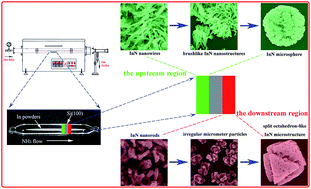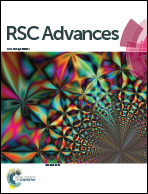The synthesis of 3D InN architectures via chemical vapor deposition and their optical properties†
Abstract
The indium nitride (InN) nanostructure is critical for the fabrication of optoelectronic and electronic devices. To date, great progress has been achieved in the controlled synthesis of low-dimensional nanostructures such as nanowires. However, the growth of the self-organized well-defined three-dimensional (3D) superstructures of uniform nanowires has rarely been reported. Herein, two types of 3D InN microstructures, which were synthesized by using chemical vapor deposition (CVD), were studied in detail to understand the growth mechanisms involved in the so-called “self-organization” schemes. The observations suggest that the formation of the InN microsphere and the split octahedron-like microstructure could be attributed to the different self-organization processes. However, the growth mechanisms of the 3D InN microstructures are substantially different from previous reports. The photoluminescence (PL) spectra of the InN microstructures recorded under room temperature conditions with a broad photoluminescence emission band can be clearly observed in the spectrum range of 540–800 nm, which strongly suggests that the obtained microstructures is a direct semiconductor that exhibits a band gap of ∼2.17 eV. Thus, it is anticipated that controlling the growth processes may be a potential route to tailor the morphology, microstructure, and even the properties of materials.


 Please wait while we load your content...
Please wait while we load your content...